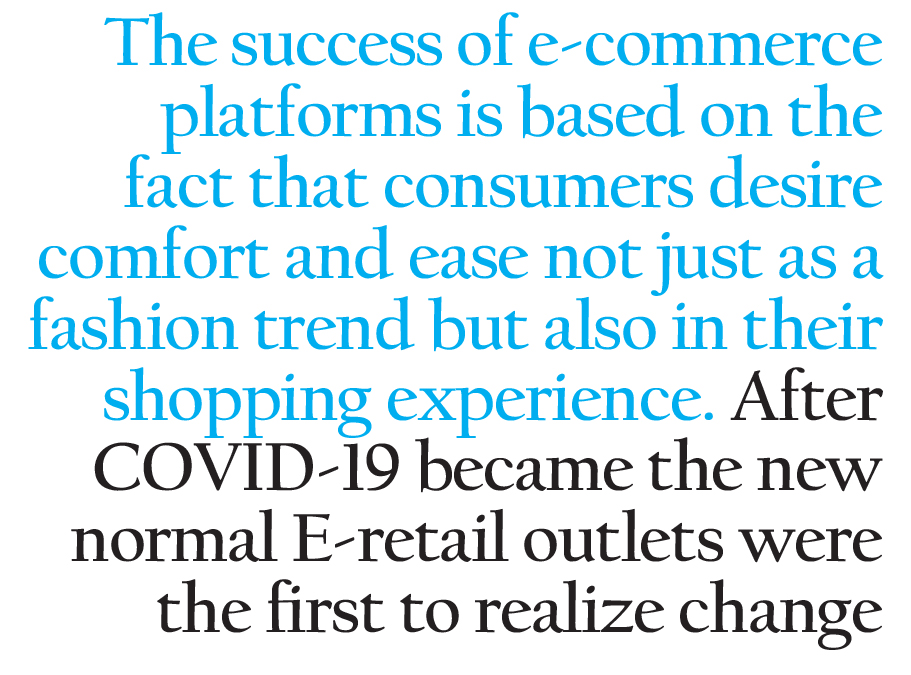The pandemic transformed the world of e-commerce irrevocably. Where many industries hit rock bottom, some sky-rocketed to new growth levels. As lockdown and curfews became the new normal, more and more people shifted to purchasing items online, hence raising the eCommerce market share by 35% between Q1 FY 2021 vs FY Q1 2020.
Global forecasts show that by 2040, 95% of all retail sales will be made online. Similarly, where global growth used to be driven by a domestic buyer buying from a domestic seller, recently purchasing from foreign sellers gained traction as the share of buyers climbed from 15% to 21%. This increase in buyers demanded that all businesses make tough decisions, adapt, and most importantly think on their feet.
The success of e-commerce platforms is based on the fact that consumers desire comfort and ease not just as a fashion trend but also in their shopping experience. After COVID-19 became the new normal E-retail outlets were the first to realize change; swiftly shifting from office wear to casual wear as the consumers in developed economies started Work from Home. In the coming months of lockdown, they served consumers with comfortable, friction-free shopping. Next, it was the furniture industry’s turn. While it usually saw its peak in the wedding season, it also found a new opportunity as people started putting up their home office and workstations and looked for reasonably priced tables and chairs.
The third industry that simultaneously adapted was the delivery services. They provided hassle-free deliveries as the demand for the best and healthiest products and the trend for home-cooking rose. While some stores went online using social media platforms like Whatsapp Business, others went out of business! All this evolution led to three key trends: i) the rise of social commerce, ii) the advent of quick or now commerce, iii) and finally the arrival of headless commerce.
The rise of social commerce
Social commerce is a subset of e-commerce that uses social platforms to enable sale transactions, by allowing individuals and organizations to buy and sell products within the platform. This model moves social media beyond its traditional role in the discovery process by encouraging users to complete the entire purchase process without leaving their preferred apps. Research suggests that individuals use social media to get advice and reviews from trusted sources before making a purchase. Hence, any brand that is “advised” more often than others can gain the trust of a customer over other retailers.
These benefits and many more have made social commerce a growing portion of a company’s marketing-driven revenue. According to The State of Social Media Investment Report, about eight in 10 businesses expect to be selling their products or services via social commerce within the next three years. In 2020, Facebook, Instagram, and Pinterest launched revamped social commerce tools to help retailers streamline online shopping experiences amid the pandemic.

This model is beneficial because it provides a ready-made audience for brands looking to market online. Every day more and more users join Facebook, Instagram, WeChat, TikTok, and other social networks creating more and more users that can become potential customers. The icing on the cake however is that the interaction of a brand is based on the customer’s social behavior on the platform, this allows organizations to streamline their communications and avoid interacting with irrelevant audiences.
As more people shop through screens, the chances of cart abandonment inevitably go up. Hence, the key determinant of a business’s conversion rate has become design seamless checkout journeys that minimize drop-off points. The ease of buying from social media platforms means that customers do not have to navigate away between the discovery and purchase stages.
Social shops can also serve as a focus group. Advertisers can collect instant feedback and listen to messages directly which would be lost in translation between the many stakeholders involved. Brand engagement on these platforms can also help in optimizing search ranking by directing more traffic towards your social media pages. Since social media platforms like Facebook generate their own traffic, the cost of customer acquisition for businesses decreases. Easy and seamless checkout processes result in higher conversion rates, higher average sales, more frequent sales, better reviews, and even more referrals.
Measuring the success of social commerce campaigns is a matter of tracking retweets, likes, shares, and clicks. Another indicator can be the amount of people that decided to click on your shoppable ads. Shoppable adverts have checkout capability which triggers when a customer clicks the “shop now” or “buy now”. These buttons enable customers to make instant purchases.
Headless Checkout
In a traditional online shopping experience, a customer lands on an ad or email and is then directed to a website. After locating the product they saw on the ad (God help if the website is not mobile optimized), they are directed to Checkout. 70% of people drop off here and, if somehow the customer makes it through the checkout, a purchase is finally made. The journey can be as short as 8 clicks or as long as 13 clicks, bear in mind here that every click is an opportunity for the potential customer to change their mind. It’s no surprise then that the current check-out processes are ineffective and increase the risk of cart abandonment.
Take those unnecessary clicks away and bring your customer to what we call a headless checkout. Here a customer clicks the ad, link, image, or whatever media is on display and is directed straight to checkout and for instant purchase. It separates the purchase and payment experience from the company’s store entirely. With headless checkouts, buyers can make purchases from virtually anywhere. bSecure is a pioneer in the headless checkout journey in Pakistan. Their first campaign in April 2021 with Reciktt’s “Veet Men’s Cream” gave a conversion rate of 3.8% vs an industry average of 1.2%-1.3%. How did they achieve this? It was not sorcery but the magic of removing needless redirects and building a quick seamless journey in just 3 clicks. Now imagine the power of social commerce with headless checkout capability wrapped in a delightful customer experience with almost immediate delivery. Quick commerce or Q-Commerce turns this dream into a reality.
Qcommerce:
Q-commerce is the future of online retail operating on the exciting edge of innovation in delivery. Q-commerce stands for quick commerce – meaning consumers enjoy ultra-fast delivery service and have their goods in under an hour. Delivery Hero, founded in 2008 was one of the first food delivery apps and now delivers household goods to customers’ homes in less than half an hour, often even faster.

During lockdowns and curfews, customers had no choice but to look for safe, reliable, and swift options. PandaMart, Bykea, and Careem services, as well as other etailers like “jaldi saman” or “24seven.pk” and hypermarkets like Carrefour all, introduced same day delivery and some even provided ultra-fast 60 minutes delivery. Currently, Pandamart delivers some items in 25 minutes which is valuable for customers because it means that it is quicker to order in than to go out. This gears the industry towards customer’s ease and convenience and is also encouraging brands to get on the bandwagon of instant gratification.
With rising customer expectations, we are not far from the time when the concept of quick commerce will be a norm and only those that can adapt to this new normal will survive, unfortunately as 2020 showed, the rest will go to dust.
Trends to keep an eye out for:
- Dark stores, where a former supermarket space is converted into an e-commerce fulfillment warehouse for online demand, such as those used by Pandamart by Foodpanda, Airlift, and Cheetay.
- Plug-and-play solutions coming to the rescue for headless commerce to scale.
- Omnichannel businesses built on a single platform that connects workflows and data sources, as well as manages all the sales channels in one place with third-party integration options.
E-commerce is an indispensable part of the retail market that has gone under substantial transformation since the pandemic hit. As digitization increases, consumers from all over the will be able to enjoy an online shopping experience. This opens endless doors of opportunity for brands, marketers, and sellers to improve their existing processes and make them fit the virtual bill. The true solution needs only two simple things; an idea or product which truly solves a problem and secondly a streamlined purchase journey – one which makes the purchase process easy and starts where the customer is most active.
























Interesting article. Undeniably, eCommerce is the future of the business. But in Pakistan, the SME sector is still havig a difficult time to undergo this transition especially those who have been doing things conventionally for several years in the past. It is hoped that they too will soon join the bandwagon.
Excellent read after a very long time.
Thank you Mehwish for such an amazing article.
My opinion:
The e-commerce market in Pakistan is yet far from international standards. Product display or E-commerce merchandising is yet a skill to be learnt by many.